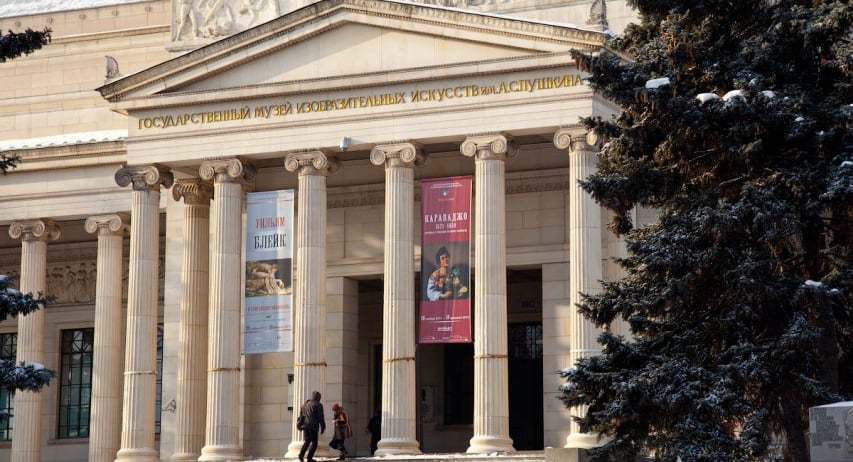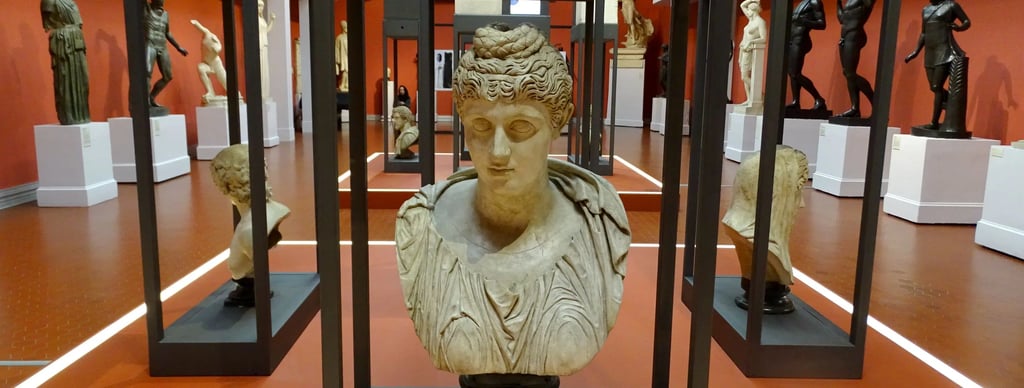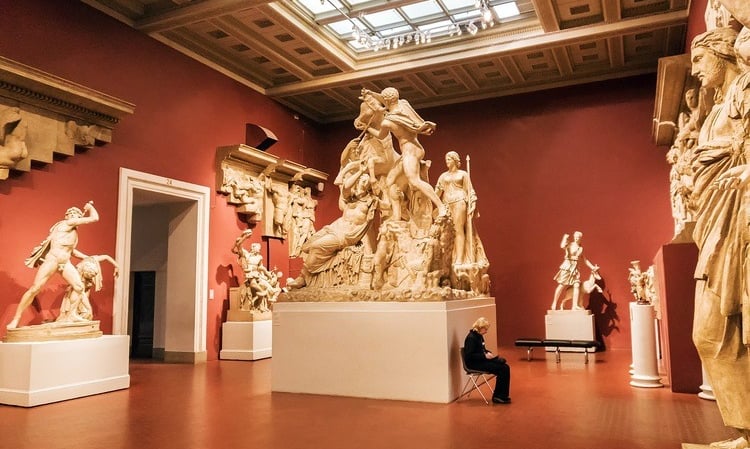Pushkin State Museum of Fine Arts: A Journey Through the World's Treasures in the Heart of Moscow
Step beneath the neoclassical columns and into a timeless world where the art of millennia greets you — a sanctuary where gods, emperors, saints, and artists whisper across the centuries.


An Ode to World Art
In a city steeped in history and tradition, the Pushkin State Museum of Fine Arts stands as a gateway to the wider world — an institution where the grand sweep of human creativity is celebrated in all its forms. From ancient Egyptian relics to Renaissance masterpieces, from the solemn beauty of Greek statuary to the bold experiments of modern art, the Pushkin Museum offers an unparalleled journey through civilization’s artistic legacy.
Located just steps from the Kremlin and Red Square, in the elegant Volkhonka Street district, the museum is one of Russia’s greatest cultural treasures. But unlike the Tretyakov Gallery, which champions Russian art, the Pushkin Museum is dedicated to the art of the world. Its mission is to bring the masterpieces of many lands to the Russian people and to foster dialogue between global cultures.
The Dream of Ivan Tsvetaev
The story of the Pushkin Museum begins with the dream of one remarkable man: Ivan Vladimirovich Tsvetaev. A philologist, art historian, and professor at Moscow University, Tsvetaev was passionately convinced that Russia needed a museum of classical art — a place where students and citizens alike could encounter the achievements of world culture firsthand.
Inspired by the great museums of Europe, especially the Louvre and the British Museum, Tsvetaev tirelessly campaigned for his vision. His dream found a patron in Yury Nechaev-Maltsov, a wealthy glass manufacturer and art lover, who provided crucial funding.
Construction began in 1898 under the inspired guidance of architect Roman Klein, whose grand design blended neoclassical style with modern engineering. The museum opened to the public in 1912 as the Alexander III Museum of Fine Arts. It was renamed in honor of Alexander Pushkin in 1937, marking the centenary of the poet’s death — though Pushkin himself had no direct connection to the museum.
A Temple of Antiquity
Entering the Pushkin Museum is like stepping into an ancient temple. The main building’s grand portico and soaring halls evoke the spirit of classical antiquity, a fitting introduction to the treasures within.
The museum’s original core was a vast collection of plaster casts of famous sculptures from Greece, Rome, and the Renaissance — an educational resource for Russian artists and scholars. Today, the Cast Gallery remains one of the world’s finest, offering an immersive encounter with the sculptural masterpieces of the past.
Here, beneath vaulted ceilings and shafts of filtered light, you walk among Michelangelo’s David, Donatello’s St. George, the friezes of the Parthenon, and the serene forms of Greek kouroi. These casts — far from mere copies — possess a powerful presence, embodying the enduring ideals of beauty and proportion.
Ancient Civilizations Come Alive
Beyond the casts, the Pushkin Museum houses a rich collection of ancient artifacts that brings the distant past vividly to life.
In the Egyptian halls, statues of pharaohs, funerary stelae, and hieroglyphic inscriptions transport visitors to the land of the Nile. The collection includes mummies, painted coffins, and amulets — tangible traces of an ancient civilization’s beliefs about life, death, and the divine.
The Antiquities of the Near East section showcases treasures from Mesopotamia, Persia, and Anatolia. Clay tablets inscribed with cuneiform script reveal the origins of writing itself, while ornate jewelry and ceremonial vessels speak of ancient splendor.
In the Greek and Roman galleries, one encounters pottery adorned with scenes of myth and daily life, delicate glassware, bronze statuettes, and marble busts of philosophers and emperors. These artifacts evoke the intellectual ferment and aesthetic refinement of the classical world.
European Masterpieces: The Heart of the Collection
The soul of the Pushkin Museum lies in its collection of European paintings, an extraordinary assemblage that spans the Middle Ages to the modern era. Though smaller than the Hermitage’s vast holdings, the Pushkin’s painting galleries offer a jewel-box experience, with each room revealing carefully chosen masterpieces.
In the halls of Italian Renaissance art, the visitor meets the luminous Madonnas of Botticelli and the tender Holy Families of Raphael. The dramatic chiaroscuro of Caravaggio brings sacred narratives to visceral life, while the serene compositions of Piero della Francesca embody a timeless order.
Moving north, the galleries of Flemish and Dutch art dazzle with the vibrant realism of Rubens, the luminous interiors of Vermeer, and the haunting portraits of Rembrandt. Here, the everyday and the eternal meet in masterful dialogue.
The French collection is particularly rich, thanks to early acquisitions and the generous donations of collectors such as Sergei Shchukin and Ivan Morozov. Impressionist and Post-Impressionist works form the beating heart of this ensemble.
In these rooms, one can stand spellbound before Monet’s water lilies, Degas’s dancers, Renoir’s sun-dappled scenes, and Cézanne’s crystalline still lifes. The bold visions of Van Gogh and the revolutionary compositions of Matisse and Picasso mark the dawn of modern art.
A Sanctuary of the Modern
The Pushkin Museum is not content to rest on the laurels of the past. Its mission embraces the living currents of contemporary art, fostering dialogue between tradition and innovation.
The Gallery of 19th and 20th Century European and American Art, housed in a nearby wing, offers a dynamic panorama of modern creativity. Here, the radical experiments of the Fauves, Cubists, Surrealists, and Abstract Expressionists unfold in bold visual statements.
Temporary exhibitions bring cutting-edge artists from around the world to Moscow, ensuring that the Pushkin remains a living laboratory of ideas. Multimedia installations, video art, and cross-disciplinary projects keep the museum firmly engaged with the present.
A Poetic Space for Reflection
Beyond its collections, the Pushkin Museum offers a space for contemplation and cultural dialogue. Its airy atriums, tranquil sculpture courtyards, and elegant galleries invite visitors to linger, to lose themselves in the beauty of art.
The museum’s programming reflects its cosmopolitan spirit. Concerts, lectures, film screenings, and literary evenings draw diverse audiences, transforming the Pushkin into a vibrant cultural hub.
Educational programs serve learners of all ages, while collaborations with international museums bring new perspectives and foster global exchange.
Practical Information
Location
Pushkin State Museum of Fine Arts
12 Volkhonka Street, Moscow, Russia
Opening Hours
Tuesday — Sunday: 11:00 — 20:00
Closed on Mondays
Please note that hours may vary by exhibition hall or event. Check the official website for the latest updates.
Tickets
Entrance tickets are available online and on-site. Separate tickets may be required for temporary exhibitions or the 19th–20th century art wing. Concession rates are available for students, teachers, seniors, and large groups.
Public Transport
Nearest metro station: Kropotkinskaya (Red Line), just a short walk from the museum entrance.
Accessibility
The museum is equipped with ramps, lifts, and services for people with limited mobility. Special programs are also available for visitors with visual and hearing impairments.
Museum Services
Audio guides and multilingual printed guides
Guided tours (in Russian, English, and other languages)
Lecture halls, workshops, and children’s programs
Bookshop and gift store
Museum café and rest areas
Events and Programs
The museum hosts classical music concerts, scholarly symposia, film screenings, and special cultural nights throughout the year. It is particularly famous for its December Nights festival — a month-long celebration of music and art.
For current exhibitions, ticketing, events, and virtual tours, visit the official site:
https://www.pushkinmuseum.art


An Architectural Symphony
The very building of the Pushkin State Museum of Fine Arts is itself a work of art. Designed by Roman Klein in collaboration with Vladimir Shukhov, the museum was among the first in Moscow to use reinforced concrete, combining technical innovation with classical grandeur. Its majestic façade, inspired by Greco-Roman temples, features Ionic columns and a pediment worthy of antiquity, while its vast, glass-roofed interior spaces flood with light like the courtyards of ancient palaces.
The layout of the museum encourages both movement and stillness. Wide staircases lead to lofty galleries; quiet nooks allow for solitary reflection. At every turn, light and form play together, echoing the harmonies of the artworks themselves. There is something spiritual in the way the architecture serves the collection — never overwhelming, always guiding.
Recent expansions, including the Museum Quarter Project, aim to connect neighboring buildings into a unified museum campus, complete with state-of-the-art galleries, conservation labs, and education centers. This ambitious development reflects the Pushkin’s desire to become not just a museum, but an international cultural engine for the 21st century.
A Tribute to Universal Culture
In a nation where cultural identity is so deeply rooted in tradition and history, the Pushkin Museum plays a vital complementary role. It offers Russians — and the world — a window into other civilizations, fostering appreciation for the shared human quest for beauty, meaning, and truth.
While the Tretyakov Gallery shows Russia to herself, the Pushkin Museum opens the doors to the world’s vast artistic heritage, encouraging connection over isolation, understanding over prejudice.
In an era of geopolitical tension and cultural misunderstanding, the Pushkin stands as a beacon of humanistic values. Here, the art of Persia, Egypt, France, Italy, and America coexists peacefully under one roof, reminding us of what unites rather than divides.
Treasures Not to Miss
Among the many marvels housed within the Pushkin’s walls, some works and exhibits are not to be missed:
Caravaggio’s The Lute Player: A masterpiece of light, music, and sensuality, radiating the intensity of Baroque realism.
Van Gogh’s Red Vineyard: Said to be the only painting he ever sold during his lifetime, this fiery canvas glows with emotional power.
Monet’s Rouen Cathedral Series: A poetic meditation on light and form, capturing the cathedral’s shifting moods across time.
Degas’s Dancers: An intimate glimpse into the quiet discipline behind the grace of the stage.
Greek Sculptural Casts: Including the full-scale casts of the Parthenon frieze, these offer a rare chance to see antiquity as it once was.
Egyptian Sarcophagi and Mummies: A rare look at funerary rituals and beliefs from the cradle of civilization.




